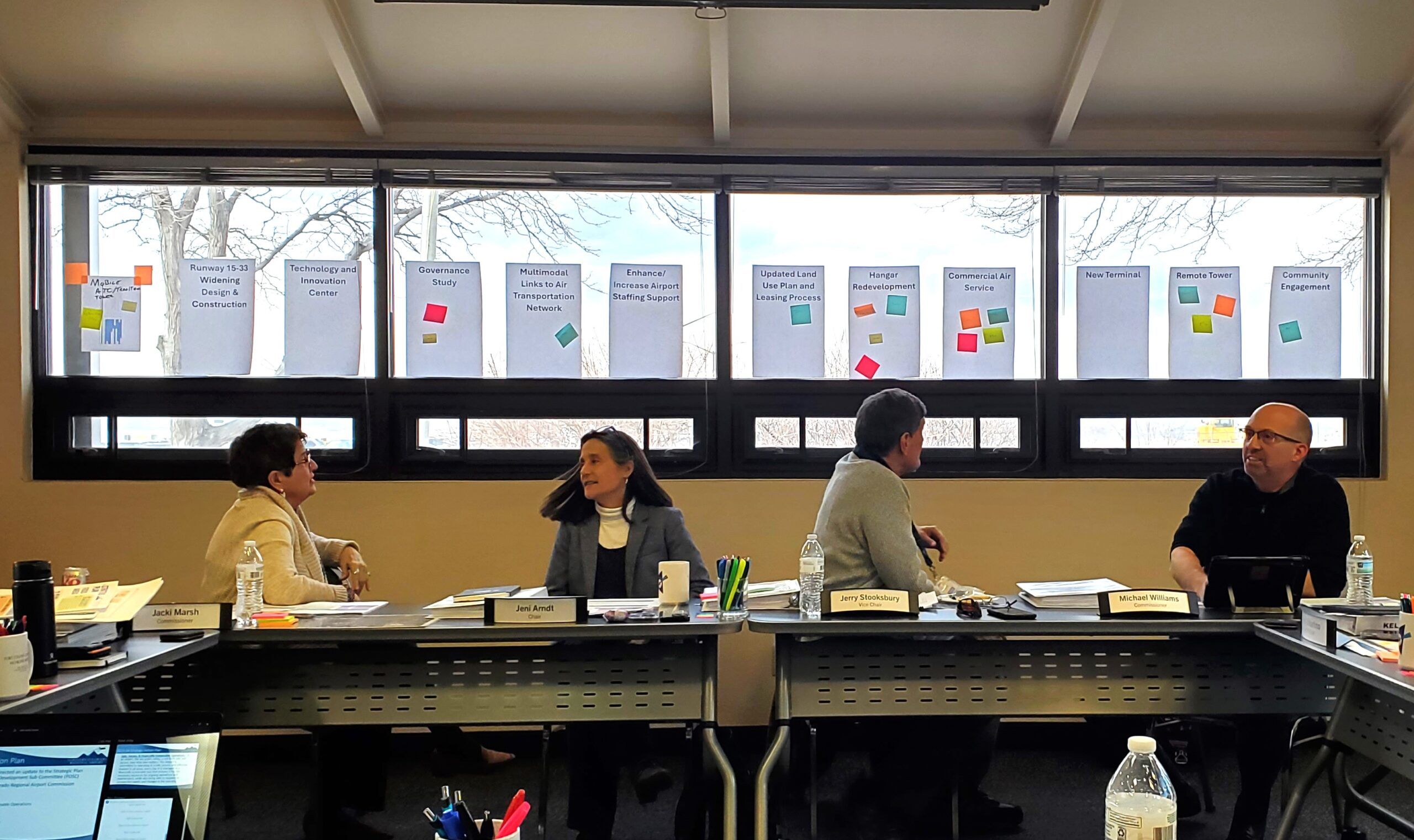Airport seeks proposals to build new hangars

LOVELAND – Hoping to resolve an issue that has roiled Northern Colorado Regional Airport for more than a year, its revamped governing commission voted unanimously on Thursday to direct its staff to draft requests for proposals to build new general-aviation hangars on three sites on the airport.
The 6-0 vote came at the end of a nearly six-hour day for the panel, including a regular meeting that went well into overtime and that followed a work session in which the commission defined its priorities for the facility’s future.
The seven-member commission has undergone a massive overhaul since last March, when a storm of controversy erupted after it attempted to evict 47 general-aviation tenants from four hangars it initially deemed unsafe. Only three members remain from that panel: Fort Collins Mayor Jeni Arndt, Fort Collins City Manager Kelly DiMartino and Avionics Specialists LLC president Jerry Stooksbury.
SPONSORED CONTENT
Fort Collins citizen representative Tom Fleming left last summer and was replaced by Delta Airlines captain Michael “Mick” Williams. Former commission chairman Don Overcash lost his seat on the panel when he failed in his bid to unseat Jacki Marsh as Loveland mayor in last November’s election and was succeeded by Marsh. Steve Adams left the commission after resigning as Loveland city manager last month and was replaced by new Loveland city council member Troy Krenning. And on Thursday, Marsh announced that Loveland’s appointed citizen representative Curt Burgener, vice chairman of the board of Transpro Burgener and owner of Burgener Holdings Inc., master developers of the Airpark North industrial area near the airport, had resigned from the commission.
In addition, Jason Licon resigned as airport director last summer and was replaced on an interim basis by David Ruppel. Commissioners on Thursday discussed a timeline for appointing a new director and were encouraged to start the process promptly by Martin Lind, who owns the Discovery Air facility on the airport grounds.
Lind said Colorado’s desirability as a place to live should make that process easy but also encouraged the airport to make the offer worthwhile because “when you pay peanuts, you get monkeys.”
Krenning moved to have Loveland’s acting city manager begin the search process immediately, and the motion passed 6-0.
The commission’s new mix seemed more receptive to the pleas of Lind and other stakeholders for the airport to accept the requests for proposals from private entities to build commercial facilities at the airport, as well as hangars for general-aviation tenants on the airport’s sites “B” and “C” and west of the main north-south runway.
Lind last year had threatened litigation against the city of Loveland, alleging that the airport, jointly owned by the cities of Loveland and Fort Collins but within the Loveland city limits, had granted “preferential treatment and exclusive rights to JetCenters of Colorado” at the expense of its competition including Lind’s Discovery Air.
Aaron Ehle, the airport’s planning and business development specialist, said the facility had 180 acres of developable land but little to no shovel-ready property.
“What we’ve heard from members of the commission, and a lot of this came out of the JetCenter proposal, was that they weren’t comfortable with unsolicited proposals,” Ehle said, adding that a “misconception about transparency” was responsible for “a lot of the frustration with the JetCenter proposal. By the time it got to the commission, a lot of that proprietary information had already been stripped out.”
Scott Schorling, Loveland’s business development project manager, added that after meeting with airport stakeholders, “we think the best path forward is to contract with an aviation real-estate specialist” who could market the airport.
However, Lind responded, “with all due respect, that wasn’t at all what this stakeholder thought about this. Private development needs to be the one that markets a property.
“The airport has a site that my company spent a lot of money on, and we submitted an RFP for about 150 general-aviation hangars when the JetCenter thing was going on. We never received anything back from the subcommittee or the staff; it was just rejected. Right now that area on your master plan is zoned for general aviation.
“You hiring a broker to come in and market this place is paying someone to come in and create new people to hate you,” Lind said. “You’ve got people in this room who want to develop. You don’t need a broker. You just need to take what you have and fill it up.”
Stooksbury and Krenning agreed. “We’ve got demand falling all over us,” Stooksbury said, and Krenning noted that “we’ve got three entities that want to develop in site B.”
Stephen Hayne said he had submitted a proposal for that site to build 80 to 100 units.
“My group, we built 30 T-hangars about 10 years ago,” he said. “We’ve done it before. We’re just a bunch of private pilots. We all got together, we were self-funded, and we built them. We know what we’re doing. We can do it again.”
Earlier in the meeting, Ruppel reported that safety-oriented repairs to the “C” hangars should be completed by the end of this month or the first part of March, and that demolition of the “A” and “B” hangars, which studies had shown to be beyond repair, would be delayed until some asbestos is removed. At that point, he said, a request for proposals to do the demolition work would be issued.
Creating more hangar space was ranked as the commissioners’ top priority during the work session that preceded the regular meeting. Francis Robbins, the airport’s operations and maintenance manager, asked them to paste sticky notes on 12 labeled sheets of paper taped to the windows behind the dais to indicate which issue was most important to them. They could choose between a mobile or brick-and-mortar air traffic control tower, widening of the main north-south runway, a technology and innovation center, acting on the recently issued governance study, establishing multimodal links to an air transportation network, increasing airport staff, an updated land-use and leasing plan, hangar redevelopment, community engagement such as more events and educational opportunities, and deciding whether to work to bring scheduled commercial airline service back.
Williams noted that the exercise would show “this is what we want to be when we grow up,” and Krenning added that it also would determine “which should we abolish as being no longer relevant.”
Regarding the runway, Ruppel told commissioners that the airport sees around 110,000 individual takeoffs and landings a year, and based on its infrastructure, the Federal Aviation Administration would consider an annual service volume of 250,000 to be its full capacity. He said at 60% of ASV, or around 123,000 takeoffs and landings a year, the FAA would advise the airport to start planning to build a parallel runway, and to start building it if the ASV reached 80% of ASV, or around 164,000 takeoffs and landings.
Grants are available to help with that expense, Ruppel said, but “we don’t get the grant unless we have a reason for the grant.”
Northern Colorado Regional Airport's revamped governing commission voted unanimously on Thursday to direct its staff to draft requests for proposals to build new general-aviation hangars.
THIS ARTICLE IS FOR SUBSCRIBERS ONLY
Continue reading for less than $3 per week!
Get a month of award-winning local business news, trends and insights
Access award-winning content today!

